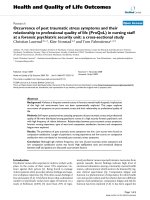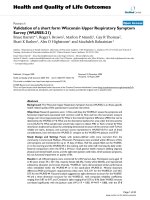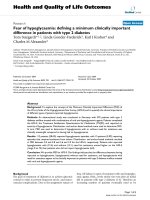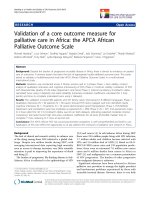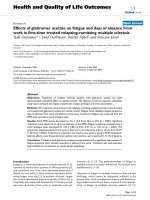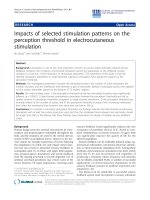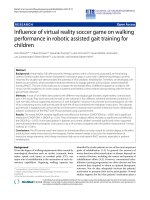Báo cáo hóa học: " Fabrication of Porous TiO2 Hollow Spheres and Their Application in Gas Sensing" pdf
Bạn đang xem bản rút gọn của tài liệu. Xem và tải ngay bản đầy đủ của tài liệu tại đây (382.29 KB, 5 trang )
NANO EXPRESS
Fabrication of Porous TiO
2
Hollow Spheres and Their Application
in Gas Sensing
Gang Yang
•
Peng Hu
•
Yuebin Cao
•
Fangli Yuan
•
Ruifen Xu
Received: 31 March 2010 / Accepted: 19 May 2010 / Published online: 3 June 2010
Ó The Author(s) 2010. This article is published with open access at Springerlink.com
Abstract In this work, porous TiO
2
hollow spheres with
an average diameter of 100 nm and shell thickness of
20 nm were synthesized by a facile hydrothermal method
with NH
4
HCO
3
as the structure-directing agent, and the
formation mechanism for this porous hollow structure was
proved to be the Ostwald ripening process by tracking the
morphology of the products at different reaction stages.
The product was characterized by SEM, TEM, XRD and
BET analyses, and the results show that the as-synthesized
products are anatase phase with a high surface area up to
132.5 m
2
/g. Gas-sensing investigation reveals that the
product possesses sensitive response to methanal gas at
200°C due to its high surface area.
Keywords Porous TiO
2
Á Hollow sphere Á
Hydrothermal synthesis Á Gas sensing
Introduction
In recent decades, nanostructured materials have attracted
much attention due to their special structure and excellent
properties in optics, electrics, magnetics, chemistry, etc.
[1–4]. In particular, titanium dioxide (TiO
2
), as an impor-
tant IV–VI group semiconductor with a band gap of
3.2 eV, has been widely applied in chemical industry,
electronic industry, environmental protection, cosmetics
industry, medical science and so on [3–6]. In order to
improve their performances, nanostructured TiO
2
with
various structures, including nanoparticles [7], nanotubes
[8], nanorods [9] and nanospheres [10], has been investi-
gated and fabricated successfully. Among these structures,
hollow structure, as a new special class of materials, has
increasingly attracted interest because of its higher specific
surface area, lower density, greater delivering ability, bet-
ter permeation and stronger light-harvesting capacity
compared to solid ones [11–13].
Up to now, many synthetic strategies have been devoted
to synthesize nanomaterials with hollow structures. Among
them, hard-template is typically used to fabricate hollow
spheres and many different materials, such as carbon (C),
polystyrene (PS), styrene-methyl methacrylate copolymer
(PSMMA), have been used as templates [14–17]. These
preparations often require removal of the templates after
synthesis, which may damage the desired configurations
of the hollow spheres. Other methods, including sol–gel,
microemulsion and self-assembly method [18–20], are also
adopted to synthesize hollow structures. However, these
methods always need to add surfactant or organic solvent,
which perhaps introduces impurities to the products and
increase the cost.
In this paper, we report a facile method to fabricate por-
ous TiO
2
spheres with hollow structure, and this work is
based on our previous work to synthesize monodisperse
Fe
3
O
4
hollow microspheres [21]. Based on the initial
reports, it should be noted that NH
4
HCO
3
plays an important
role in the formation of the hollow structure and can be
further confirmed in the current report. The synthesized
products are composed of porous shell, which makes
the sample a large specific surface area of 132.5 m
2
/g.
Gas-sensing investigation reveals that the product possesses
G. Yang Á R. Xu
College of Materials Science and Engineering, Beijing
University of Chemical Technology, 100029 Beijing, China
G. Yang Á P. Hu Á Y. Cao Á F. Yuan (&)
State Key Laboratory of Multi-phase Complex System, Institute
of Process Engineering, Chinese Academy of Sciences,
100190 Beijing, China
e-mail: fl
123
Nanoscale Res Lett (2010) 5:1437–1441
DOI 10.1007/s11671-010-9658-2
sensitive response to methanal gas due to its high surface
area, and the results reveal that this special structure may
have potential properties and applications in some related
fields.
Experimental
Preparation of TiO
2
Hollow Spheres
All reagents are analytically pure and used without further
purification. In a typical experiment, a mixture of 4 mL of
tetrabutyl titanate (TBOT) and 20 mL of ethanol was
dropped into 100 mL of deionized water under magnetic
stirring to form an ivory-white sol. Then, the resulting
mixture was divided into three parts, and one of them was
transferred to a 100-mL Teflon-lined autoclave, followed
by the addition of 1 g of NH
4
HCO
3
and filling with ethanol
up to 70% of the total volume. The autoclave was main-
tained at 180°C for 48 h. After reaction, the autoclave was
cooled to room temperature. The product was obtained by
centrifuging and sequentially washing with water and
ethanol for several times and then dried in a vacuum oven
at 60°C for 5 h.
Characterization
The phase of the product was determined by X-ray dif-
fraction (XRD) patterns, which were recorded with a Phi-
lips X’Pert PRO MPD X-ray diffractometer using Cu Ka
radiation (k = 1.54178 A
˚
). The morphology and structure of
the product were then observed by a scanning electron
microscope (SEM, JEOL JSM-6700F) and a transmission
electron microscope (TEM, JEOL JEM-2100). The pore size
distribution and Brunauer–Emmett–Teller (BET) surface
area were calculated from the nitrogen adsorption–desorp-
tion isotherm that is obtained by using an Autosorb-1
automatic surface area and pore size distribution analyzer.
The gas-sensing property was tested in a home-made
instrument as reported earlier [22].
Results and Discussion
The morphology and structure of the synthesized products
are shown in Fig. 1. From the typical SEM image of the
obtained products shown in Fig. 1a, we can see that uni-
formly spherical particles with a diameter of 100 nm were
obtained in the experiment, and no particles with other
shape were found. A magnified SEM image reveals the
detailed morphology, as shown in the inset of Fig. 1a,
which indicates that as-synthesized spheres were composed
of fine nanocrystallites, with a rough surface and maybe
have pores in it. The porous hollow structure was further
investigated by the TEM image as shown in Fig. 1b, and
the intensive contrast between center and edge of the
spheres indicates the formation of hollow structure in the
final products, and the shell thickness of the spheres is
about 20–25 nm. The bright spots scattered in the dark
shell also confirm that the shell is porous. The crystal
Fig. 1 a SEM image, b TEM
image, c XRD patterns, d
Nitrogen absorption–desorption
isotherms and corresponding
pore size distribution of TiO
2
hollow spheres synthesized at
180°C for 48 h
1438 Nanoscale Res Lett (2010) 5:1437–1441
123
structure of the TiO
2
sample was determined by XRD
analysis as shown in Fig. 1c. All the diffraction peaks can
be well indexed to anatase phase of TiO
2
(JCPDS 71-
1169). No peaks of impurities were detected in the XRD
patterns, indicating the high purity of the products. The
strong and sharp peaks also confirm the well crystallization
of the synthesized products.
Figure 1d gives the nitrogen adsorption–desorption
isotherms and corresponding pore size distribution of the
TiO
2
product. The isotherm shown in the Fig. 1d can be
well classified as type IV isotherm, indicating the forma-
tion of a typical porous structure [23]. The corresponding
pore size distribution (the inset in Fig. 1d) was calculated
by means of Barret–Joyner–Halenda (BJH) method. From
the distribution curve, we can see that porous TiO
2
hollow
spheres possess a broad pore size distribution due to the
coexistence of mesoporous and micropores, but the pores
with diameter of 1*3 nm are dominant in the final prod-
ucts. The BET analysis confirms the high specific surface
area (132.5 m
2
/g) of the product, which comes from the
formation of the porous hollow structures.
In order to explore the evolution process of the porous
hollow structure, time-dependant experiments were con-
ducted, and Fig. 2 gives the TEM images of products
obtained at different reaction times. At the beginning of the
hydrothermal reaction, titanium dioxide crystallized grad-
ually and formed lots of small nanocrystallites. At the same
time, NH
4
HCO
3
was decomposed to NH
3
and CO
2
at
heating condition. These gas bubbles and TiO
2
nanoparti-
cles tend to aggregate together to minimize the interfacial
energy, and the spherical aggregates are then formed by
aggregation of original nanocrystallites nucleated on the
gas–liquid interface as shown in Fig. 2a. The solid aggre-
gates then followed by a solid core evacuation and a hol-
lowing effect are observed for those with a longer reaction
time of 24 h (Fig. 2b), which is due to the continuous
outward growth of the fine nanocrystallites and the gas
bubbles gathered in the center of spheres [24]. As the
reaction time further increased, the migration sustainedly
carried out to a certain degree, and the hollow sphere
structure was obviously obtained (Fig. 2c). Based on
the experimental results and analysis, the formation
mechanism of hollow structure can be interpreted as the
Ostwald ripening process [21]. After the formation of the
hollow spheres, lots of gas bubbles still existed in the shell,
and they acted as templates for the formation of the loose
packed shell. Thus, the hollow TiO
2
spheres with a porous
shell were finally obtained. XRD analyses reveal the dif-
ferent crystalline phases of products obtained at different
reaction times, typically are amorphism, brookite and
anatase. Accordingly, porous TiO
2
spheres with different
phases could be well controlled by adjusting the reaction
time in our experiments.
To investigate the adsorption property of synthesized
products, 0.1 g of sample was added into 100 mL of
aqueous methylene blue (MB) solution with different
concentrations, and then the mixture was placed in the
darkroom under magnetic stirring for 10 s. The adsorption
property of the product for MB was measured by the MB
concentration change before and after adsorption. The
concentration of MB was detected using an UV–vis spec-
trophotometer. The color change of the MB solution
(100 mg/L) after adsorption was shown in Fig. 3. The color
contrast of the MB solution before and after adsorption
indicates the excellent adsorption ability of the porous
TiO
2
hollow spheres for organic dyestuff. The test results
of adsorption property of the sample to MB were shown in
Table 1. The adsorption rate and adsorption quantity are
calculated by the Eqs. 1 and 2, respectively.
l ¼ðc
0
À cÞ=c
0
¼ðA
0
À AÞ=A
0
ð1Þ
q ¼ðc
0
À cÞÁV=m ð2Þ
(Here, l is the adsorption rate; q is the adsorption quantity;
c
0
and c are MB concentrations before and after mixing,
respectively; A
0
and A are absorbencies of the MB solution
before and after mixing, respectively; V is the volume of
the solution, and m is the mass of TiO
2
sample.)
From the Table 1, it can be seen that 96*98% of MB in
the solution can be adsorbed by the TiO
2
sample at a low
MB concentration of 50 and100 mg/L. When the concen-
tration of MB increases to 200 mg/L, the adsorption
quantity of the sample is up to 170.9 mg/g. The adsorption
quantity has no obvious increase when the concentration of
Fig. 2 TEM images of products
obtained at different reaction
times: a 0h,b 24 h and c 48 h.
Scale bar 50 nm
Nanoscale Res Lett (2010) 5:1437–1441 1439
123
MB further increases (400 mg/L), which indicates the
saturated adsorption quantity of the sample is about
171 mg/g. The high adsorption ability of this product
indicates that the porous TiO
2
hollow spheres may be used
as adsorbent in some fields such as wastewater treatment.
As the synthesized TiO
2
hollow sphere powder has a
high specific surface area and intense adsorption ability, it
is natural to consider its application in specific gas detec-
tion. The gas sensor was assembled using thin film pre-
pared from the porous TiO
2
hollow sphere powder.
Figure 4a–c gives the typical isothermal response curves of
the thin film sensor exposed to methanal (HCHO) gas at
different operating temperatures (200, 300 and 400° C). In
the gas-sensing test, HCHO gas was diluted in water vapor,
and the flow velocity of the mixed gas was controlled at
0.6 L/min. The sensor sensitivity was defined as the slope
of the R
a
/R
g
versus c curve, and herein, R
a
is the resistance
value of the sensor in clean air, R
g
is the resistance value of
the sensor in specific gas under test and c is the HCHO gas
concentration.
Based on the isothermal response curves, it can be
concluded that the resistance value of the sensor decreases
sharply when the HCHO gas passes the sensor, which
indicated the good response speed of fabricated gas sensor.
As time increases, gas diffusion slows down in the film,
leading to a corresponding slowdown of the resistance
decrease rate, resistivity finally reaching stability. When
the analyte is removed, the resistance value rises immedi-
ately and restores fast. In general, it is believed that the
sensing mechanism includes two reactions [25, 26]. First,
oxygen adsorbed on the TiO
2
sample surface captures
electrons from TiO
2
and transforms into O
ad
-
. Then, in the
reductive gas condition (here is methanal), O
ad
-
will be
Fig. 3 The color contrast of 100 mg/L MB solution before and after
adsorption. The left shows the primary solution, and the right is the
solution after adsorption by the porous TiO
2
sample for 10 s
Table 1 The adsorption property test results of the TiO
2
hollow
sphere product
MB concentration
(mg/L)
Adsorption
rate (%)
Adsorption quantity
(mg/g)
50 96.49 48.25
100 97.78 97.78
200 85.45 170.9
400 42.96 171.8
Fig. 4 Response curves to
HCHO at a 200°C, b 300°C,
c 400°C and d the response
magnitude, R
a
/R
g
versus HCHO
gas concentration
1440 Nanoscale Res Lett (2010) 5:1437–1441
123
reduced and its electron is given back to TiO
2
, leading the
electron density to increase. Therefore, in macro-view,
when the thin film sensor is exposed to HCHO, the resis-
tance value will decrease, and the relative change of
the values at different gas concentrations is used to char-
acterize gas sensitivity. Figure 4d shows the curve of
sensor-normalized resistivity (R
a
/R
g
) versus HCHO gas
concentration at different operating temperatures. It can be
clearly seen that the gas sensor at operating temperature of
200°C presents a much higher gas-sensing property than
the ones operated at 300 and 400°C. In addition, the sensor
shows a relatively linear dependence on the HCHO con-
centration at 200°C, and the fitting line equation with the
correlation coefficient of 0.9914 is as follows:
R
a
=R
g
¼ 10:52767 þ0:06798C
HCHO
ð3Þ
Up to now, few papers about TiO
2
hollow spheres applied
in gas sensing are reported. Moreover, the nanoscale TiO
2
materials with other morphologies do not exhibit very good
gas sensitivity, and the operating process needs to be
conducted in a higher temperature condition [27–29].
Compared to previous reported TiO
2
samples, our porous
TiO
2
hollow spheres have a good performance in gas
sensing at lower operating temperature. This satisfactory
gas sensitivity attributed to the porous structure and large
specific surface area indicates the importance of the
microstructure control of gas-sensing layers.
Conclusions
In summary, porous TiO
2
hollow spheres with anatase
phase were prepared by a hydrothermal method, and SEM
and TEM investigation reveals that the products have a
uniform diameter and shell thickness of about 100 nm and
20–25 nm, respectively. This preparation process is more
facile compared to other methods reported. The formation
mechanism of the porous hollow structure can be attributed
to the Ostwald ripening. The results also confirmed that the
as-synthesized hollow spheres exhibit high adsorption
ability for organic dyestuff and excellent gas sensitivity to
HCHO of the TiO
2
thin firm sensor performed at relatively
low operating temperature (200°C).
Acknowledgments The authors acknowledge the financial support
from the National Nature Science Foundation of China (No.
10905068 and 50974111).
Open Access This article is distributed under the terms of the
Creative Commons Attribution Noncommercial License which
permits any noncommercial use, distribution, and reproduction in any
medium, provided the original author(s) and source are credited.
References
1. S.J. Pearton, D.P. Norton, K. Ip, Y.W. Heo, T. Steiner, Super-
lattices Microstruct. 34, 3 (2003)
2. Y.N. Xia, P.D. Yang, Y.G. Sun, Y.Y. Wu, B. Mayers, B. Gates,
Y.D. Yin, F. Kim, H.Q. Yan, Adv. Mater. 15, 353 (2003)
3. M. Ni, M.K.H. Leung, D.Y.C. Leung, K. Sumathy, Renew. Sust.
Energ. Rev. 11, 401 (2007)
4. X.B. Chen, S.S. Mao, Chem. Rev. 107, 2891 (2007)
5. E. Stathatos, Y.J. Chen, D.D. Dionysiou, Sol. Energy Mater. Sol.
Cells 92, 1358 (2008)
6. M.G. Manera, P.D. Cozzoli, M.L. Curri, G. Leo, R. Rella,
A. Agostiano, L. Vasanelli, Synth. Met. 148, 25 (2005)
7. K.S. Yoo, T.G. Lee, J. Kim, Microporous Mesoporous Mater. 84,
211 (2005)
8. Y.Y. Song, F.S. Stein, S. Bauer, P. Schmuki, J. Amer. Chem. Soc.
131, 4230 (2009)
9. Q.S. Wei, K. Hirota, K. Tajima, K. Hashimoto, Chem. Mater. 18,
5080 (2006)
10. L. Yang, Y. Lin, J.G. Jia, X.P. Li, X.R. Xiao, X.W. Zhou,
Microporous Mesoporous Mater. 112, 45 (2008)
11. L. Jiang, Y.J. Zhong, G.C. Li, Mater. Res. Bull. 44, 999 (2009)
12. D.G. Shchukin, R.A. Caruso, Chem. Mater. 16, 2287 (2004)
13. Y.X. Zhang, G.H. Li, Y.C. Wu, Y.Y. Luo, L.D. Zhang, J. Phys.
Chem. B 109, 5478 (2005)
14. C.Y. Song, W.J. Yu, B. Zhao, H.L. Zhang, C.J. Tang, K.Q. Sun,
X.C. Wu, L. Dong, Y. Chen, Catal. Commun. 10, 650 (2009)
15. X. Du, J.H. He, Mater. Res. Bull. 44, 1238 (2009)
16. J.P. Wang, Y. Bai, M.Y. Wu, J. Yin, W.F. Zhang, J. Power
Sources 191, 614 (2009)
17. R.B. Zheng, X.W. Meng, F.Q. Tang, Appl. Surf. Sci. 255, 5989
(2009)
18. Y.X. Hu, J.P. Ge, Y.G. Sun, T.R. Zhang, Y.D. Yin, Nano Lett. 7,
1832 (2007)
19. G.L. Li, E.T. Kang, K.G. Neoh, X.L. Yang, Langmuir 25, 4361
(2009)
20. T.Z. Ren, Z.Y. Yuan, B.L. Su, Chem. Phys. Lett. 374, 170 (2003)
21. P. Hu, L.J. Yu, A.H. Zuo, C.Y. Guo, F.L. Yuan, J. Phys. Chem.
C. 113, 900 (2009)
22. N. Han, Y.J. Tian, X.F. Wu, Y.F. Chen, Sens. Actuators B 138,
228 (2009)
23. B.C. Wu, R.H. Yuan, X.Z. Fu, J. Solid State Chem. 182, 560
(2009)
24. H.G. Yang, H.C. Zeng, J. Phys. Chem. B 108, 3492 (2004)
25. K. Zakrzewska, Vacuum 74, 335 (2004)
26. W. Zeng, T.M. Liu, Physica B 405, 564 (2010)
27. M.H. Seo, M. Yuasa, T. Kida, J.S. Huh, K. Shimanoe, N. Yam-
azoe, Sens. Actuators B 137, 513 (2009)
28. A.M. More, J.L. Gunjakar, C.D. Lokhande, Sens. Actuators B
129
, 671 (2008)
29. S. Pokhrel, L.H. Huo, H. Zhao, S. Gao, Sens. Actuators B 129,18
(2008)
Nanoscale Res Lett (2010) 5:1437–1441 1441
123



